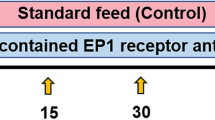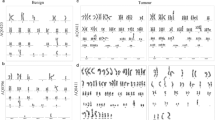Abstract
Novel synthetic antagonists of retinoic acid receptors (RARs) have been developed. To avoid interference by serum retinoids when testing these compounds, we established serum-free grown sub-lines (>3 years) of the prostate carcinoma lines LNCaP, PC3 and DU145. A high affinity pan-RAR antagonist (AGN194310, Kd for binding to RARs = 2–5 nM) inhibited colony formation (by 50%) by all three lines at 16–34 nM, and led to a transient accumulation of flask-cultured cells in G1 followed by apoptosis. AGN194310 is 12–22 fold more potent than all-trans retinoic acid (ATRA) against cell lines and also more potent in inhibiting the growth of primary prostate carcinoma cells. PC3 and DU145 cells do not express RARβ, and an antagonist with predominant activity at RARβ and RARγ (AGN194431) inhibited colony formation at concentrations (∼100 nM) commensurate with a Kd value of 70 nM at RARγ. An RARα antagonist (AGN194301) was less potent (IC50∼200 nM), but was more active than specific agonists of RARα and of βγ. A component(s) of serum and of LNCaP-conditioned medium diminishes the activity of antagonists: this factor is not the most likely candidates IGF-1 and EGF. In vitro studies of RAR antagonists together with data from RAR-null mice lead to the hypothesis that RARγ-regulated gene transcription is necessary for the survival and maintenance of prostate epithelium. The increased potencies of RAR antagonists, as compared with agonists, suggest that antagonists may be useful in the treatment of prostate carcinoma. © 2001 Cancer Research Campaign
Similar content being viewed by others
Article PDF
Change history
16 November 2011
This paper was modified 12 months after initial publication to switch to Creative Commons licence terms, as noted at publication
References
Boehm MF, Heyman RA, Patel S, Stein RB and Nagpal S (1995) Retinoids: biological function and use in the treatment of dermatological diseases. Exp Opin Invest Drugs 4: 593–612
Breitman TR, Selonick SE and Collins SJ (1980) Induction of differentiation of the human promyelocytic leukaemia cell line (HL-60) by retinoic acid. Proc Natl Acad Sci USA 77: 2936–2940
Campbell MJ, Park S, Uskokovic MR, Dawson MI and Koeffler HP (1998) Expression of retinoic acid receptor-β sensitises prostate cancer cells to growth inhibition mediated by combinations of retinoids and 19- nor hexafluoride vitamin D3 . Endocrinology 139: 1972–1979
Chambon P (1994) The retinoid signalling pathways: molecular and genetic analyses. Semin Cell Biol 5: 115–125
Chan JM, Stampfer MJ, Giovannucci E, Gann PH, Ma J, Wilkinson P, Hennekens CH and Pollack M (1998) Plasma insulin-like growth factor-1 and prostate cancer risk: a prospective study. Science 279: 563–566
Chandraratna RAS (1995) Tazarotene – first of a new generation of receptor-selective retinoids. Br J Dermatol 135: 18–25
de Vos S, Dawson MI, Holden S Le T, Wang A, Cho SK, Chen DL and Koeffler HP (1997) Effects of retinoid X receptor-selective ligands on proliferation of prostate cancer cells. Prostate 32: 115–121
Fanjul AN, Piedrafita FJ, Al-Shamma H and Pfahl M (1998) Apoptosis induction and potent antiestrogen receptor-negative breast cancer activity in vivo by a retinoid antagonist. Cancer Res 58: 4607–4610
Gao M, Ossowski L and Ferrari AC (1999) Activation of Rb and decline in androgen receptor protein precede retinoic acid induced apoptosis in androgen-dependent LNCaP cells and their androgen-independent derivative. J Cell Physiol 179: 336–346
Gorczyca W, Bigman K, Mittleman A, Ahmed T, Gong J, Melamed MR and Darzynkiewicz Z (1993) Induction of DNA strand breaks associated with apoptosis during treatment of leukaemias. Leukaemia 7: 659–670
Gyftopoulos K, Perimenis P, Sotiropoulou-Bonikou G, Sakellaropoulos G, Varakis I and Barbalias GA (2000) Immunohistochemical detection of retinoic acid receptor-alpha in prostate carcinoma: correlation with proliferative activity and tumour grade. Int Urol Nephrol 32: 263–269
Hedlund TE, Moffatt KA, Uskokovic MR and Miller GJ (1997) Three synthetic vitamin D analogues induce prostate-specific acid phosphatase and prostate specific antigen while inhibiting the growth of human prostate cancer cells in a vitamin D receptor- dependent fashion. Clin Cancer Res 3: 1331–1338
Heish TC and Wu JM (1997) Effects of fenretinide (4-HPR) on prostate LNCaP cell growth, apoptosis and prostate-specific gene expression. Prostate 33: 97–104
Johnson AT, Wang L, Standeven AM, Escobar M and Chandraratna RAS (1999) Synthesis and biological activity of high-affinity retinoic acid receptor antagonists. Bioorganic and Medicinal Chemistry 7: 1321–1338
Kang JX, Bell J, Leaf A, Beard RL and Chandraratna RAS (1998a) Retinoic acid alters the intracellular trafficking of the mannose-6-phosphate/insulin-like growth factor-II receptor and lysosomal enzymes. Proc Natl Acad Sci USA 95: 13687–13691
Kang JX, Li Y and Leaf A (1998b) Mannose-6-phosphate/insulin-like growth factor-II receptor is a receptor for retinoic acid. Proc Natl Acad Sci USA 95: 13671–13676
Klein ES, Wang JW, Khalifa B, Gavigan SA and Chandraratna RAS (2000) Recruitment of nuclear corepressor and coactivator to the retinoic acid receptor by retinoid ligands. J Biol Chem 275: 19401–19408
Landis SH, Murray T, Bolden S and Wingo PA (1998) Cancer statistics. Cancer J for Clinicians 48: 6–29
Liang JY, Fontana JA, Rao JN, Ordonez JV, Dawson MI, Shroot B, Wilber JF and Feng P (1999) Synthetic retinoid CD437 induces S-phase arrest and apoptosis in human prostate cancer cells LNCaP and PC-3. Prostate 38: 228–236
Lohnes D, Kastner P, Dierich A, Mark M, LeMeur M and Chambon P (1993) Function of retinoic acid receptor γ in the mouse. Cell 73: 643–658
Lotan Y, Xu XC, Shalev M, Lotan R, Williams R, Wheeler TM, Thompson TC and Kadmon D (2000) Differential expression of nuclear retinoid receptors in normal and malignant prostates. J Clin Oncol 18: 116–121
Lu X-P, Fanjul A, Picard N, Pfahl M, Rungta D, Nared-Hood K, Carter B, Piedrafita FJ, Tang S, Fabbrizio E and Pfahl M (1997) Novel retinoid-related molecules as apoptosis inducers and effective inhibitors of human lung cancer cells in vivo. Nature Med 6: 686–690
Lu X-P, Fanjul A, Picard N, Shroot B and Pfahl M (1999) A selective retinoid with high activity against an androgen-resistant prostate cancer cell type. Int J Cancer 80: 272–278
Lufkin T, Lohnes D, Mark M, Dierich A, Gorry P, Gaub MP, LeMeur M and Chambon P (1993) High postnatal lethality and testis degeneration in retinoic acid alpha mutant mice. Proc Natl Acad Sci USA 90: 7225–7229
Manztzoros CS, Tzonou A, Signorello LB, Stampfer M, Trichopoulos D and Adami HO (1997) Insulin-like growth factor 1 in relation to prostate cancer and benign prostatic hyperplasia. Br J Cancer 76: 1115–1118
Nagpal S, Athankar J and Chandraratna RAS (1995) Separation of transactivation and AP1 antagonism functions of retinoic acid receptor α. J Biol Chem 270: 923–927
Peehl DM, Wong ST, Terris MK and Stamey TA (1991) Culture of prostatic epithelial cells from ultrasound-guided needle biopsies. Prostate 19: 141–147
Piedrafita FJ and Pfahl M (1997) Retinoid-induced apoptosis and Sp1 cleavage occur independently of transcription and require caspase activation. Mol Cell Biol 17: 6348–6358
Pienta JK, Nguyen NM and Lehr JE (1993) Treatment of prostate cancer in the rat with the synthetic retinoid fenretinide. Cancer Res 53: 224–226
Pietrzkowski Z, Mulholland G, Gomella L, Jameson BA, Wernicke D and Baserga R (1993) Inhibition of the growth of prostatic cancer cell lines by peptide analogues of insulin-like growth factor 1. Cancer Res 53: 1102–1106
Rosenthal DS (1998) Changing trends (editorial). Cancer J for Clinicians 48: 3–4
Sherwood ER, Van Dongen JL, Wood CG, Liao S, Kozlowski JM and Lee C (1998) Epidermal growth factor receptor activation in androgen-independent but not androgen-stimulated growth of human prostatic carcinoma cells. Br J Cancer 77: 855–861
Skowronski RJ, Peehl DM and Feldman D (1994) Vitamin D and prostate cancer: 1,25-dihydroxyvitamin D3receptors and actions in human prostate cancer cell lines. Cancer Res 54: 805–810
Teng M, Duong TT, Johnson AT, Klein ES, Wang L, Khalifa B and Chandraratna RAS (1999) Identification of highly potent retinoic acid receptor α-selective antagonists. J Medicinal Chemistry 40: 2445–2451
Wallington LA, Durham J, Bunce CM and Brown G (1996) Growth of single HL60 cells in liquid culture: Analysis of the influences of differentiative agents. Leukemia Research 20: 821–829
Xie SP, James SY and Colston KW (1997) Vitamin D derivatives inhibit the mitogenic effects of IGF-1 on MCF-7 human breast cancer cells. J Endocrinol 154: 495–504
Author information
Authors and Affiliations
Rights and permissions
From twelve months after its original publication, this work is licensed under the Creative Commons Attribution-NonCommercial-Share Alike 3.0 Unported License. To view a copy of this license, visit http://creativecommons.org/licenses/by-nc-sa/3.0/
About this article
Cite this article
Hammond, L., Krinks, C., Durham, J. et al. Antagonists of retinoic acid receptors (RARs) are potent growth inhibitors of prostate carcinoma cells. Br J Cancer 85, 453–462 (2001). https://doi.org/10.1054/bjoc.2001.1939
Received:
Revised:
Accepted:
Published:
Issue date:
DOI: https://doi.org/10.1054/bjoc.2001.1939
Keywords
This article is cited by
-
SP1 and RARα regulate AGAP2 expression in cancer
Scientific Reports (2019)
-
An antagonist of retinoic acid receptors more effectively inhibits growth of human prostate cancer cells than normal prostate epithelium
British Journal of Cancer (2004)



